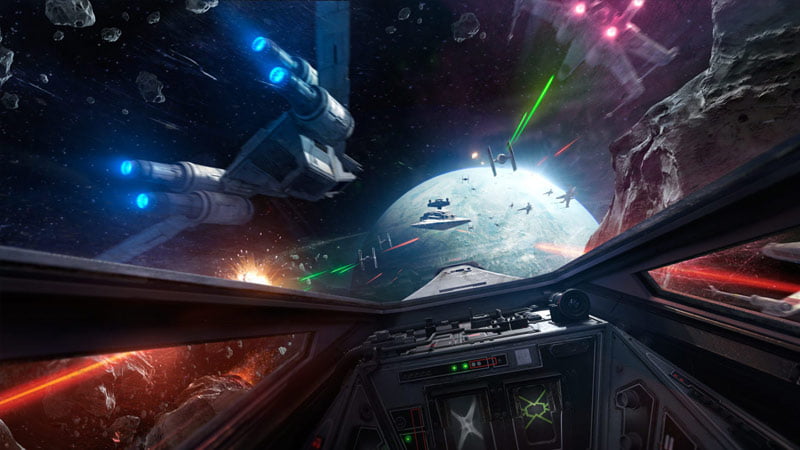The London Olympia conference centre hosted Develop: VR on Thursday, an event where a series of speakers from different studios give talks on the future of VR – and, in turn, the future of games. It was an odd experience.
Beginning at nine we are ushered through the portals of the vast conference centre and led up three flights of stairs into an expo hall. Some events are set out with the frivolous pride of a sovereign nation after striking huge oil reserves: statues of game icons adorn the halls, or perhaps a huge Deku tree rises from the floor.
But not Develop: VR. It’s adorned with corporate carpet, sensible ergonomic chairs, and trestle tables. With the exception of press, the event was, to skew Sony’s adage, For the Developers.
First among them to speak was Stuart Whyte, Director of VR Product Development for SIE’s London Studios. His talk was thought-provoking, but perhaps not in the intended way. ‘Taking VR to the Next Level – A Case Study in AAA Games Development’ it was called, and it centred on London Studio’s upcoming game, Blood & Truth.
London Studio – formerly Team Soho of The Getaway fame – has sprung from Sony’s headwater and, after the cancellation of The Getaway 3, devoted its output for over a decade on EyeToy and SingStar games. It doesn’t take long, when watching Blood & Truth in action, to see a studio returning home.
John Wick’s Cockney cousin spills profanities and bullets like dropped Tic Tacs, dispatching a litany of Guy Ritchie geezers; all the while, grime music amps up blended with an orchestral score in a melange meant, as Whyte says, to evoke London’s ‘glamour’ as well as its ‘grit’. Its lack of name actors and its easy association with B-tier Brit gangster flicks is redolent of The Getaway, as is its penchant for jarring animation.
The word on the frontline of the VR charge is, understandably, ‘immersive’. We are told that people are likening VR to the advent of the talkies; we are told that trailers can’t do justice to the experience (a real problem for trying to sell people on it); and we’re assured that it is indeed the future of the medium.
This isn’t to sound like an effete warbler or some ornery hack shutting the curtains on fun and hunkering down in zealous devotion to True Art. There is a lot to like about Blood & Truth: it looks like a sublime shooting gallery, a chance to live out the caffeinated cowboy dreams of Johns both Wick and McClane, and it pulls you into these worlds and puts the gun in your hand.
But as the word immersion hung in the air in the conference room, footage of the game betrayed these dreams. Claw-like hands with distended fingers clasped clumsily round a gun clip; the detached, floating arms of the hero clipped through the camera with egg-cup ends like a Duplo man.
At one point Whyte tells us that the suit one character wears “exists in the real world,” that it’s been scanned in to the game in the name of immersion. Sadly, well-tailored and handsome as it might be, it’s wrapped around a performance to haunt a reel of EastEnders B-roll. It seems, though it is admittedly only an early trailer, ironically named: its corridor shooting galleries look bloodless, its acting anything but true.

The truest glimpse of the magic of VR that day came from Chris O’Connor of ZeroLight, a company that renders cars in virtual reality to help sell them. His talk was called ‘Building World-Class Commercial VR Experiences’ and it demonstrated the potency of the experience, the power to pierce the present, to transport you and make you feel.
The idea of immersion is an interesting one. Any kind of art (damn, it looks like I might just be that effete warbler after all) is shown to us, in some way, framed. The edges of the television, the frame of a painting or a photograph, even music, as it floods into our heads, is incarcerated in the plastic of the iPod, or the varnished wood of the turntable.
As O’Connor spoke, the screen behind him showed the polygonal skeleton of an Audi; he spoke about the balance of detail and fidelity in rendering these cars (6 million polygons is the sweet spot). Each polygon was connected with lines like a constellation of push-pins on an astral cork board. As the camera zoomed in, stringent detail was revealed: the interiors illumined with texture and flourish, the cup-holders and dials of the dash now wrought from crisp steel and rugged leather.
He spoke about the power to stoke emotion: it may be the red stitching on a leather seat that makes a sale when it’s rendered in front of someone’s eyes in real time, or it may be the environment the car is in that forges a connection between viewer and product. One such image produced a beguiling effect: a convertible parked on a beach, clean white sand and blue waves scrubbing up toward it – O’Connor assured us that it isn’t just the car, but the entire environment, that brings it to life. It can mean the difference between selling and not.
VR isn’t like 3D films or interactive theatre, where the work lives on or spills off the proscenium. VR feels more like a Victorian stereoscope: you are engulfed by what you’re seeing, as reality recedes and is replaced. In this new space immersion can be compromised more easily. As stumbling neophytes we fumble for edges of our own. We peer through walls; our hands hang in the air disembodied; or else we come into painful contact with a reality not so virtual, banging our hands or heads on nearby surfaces.

The most powerful experiences in this place are ones just like the stereoscope: you simply look and inhabit. The moments where your macerated nerves jangle with terror in Shark Encounter, or the moment of inertia in a game like Star Wars Battlefront Rogue One X-Wing VR Mission where you’re transfixed like a fly in amber in awe of a Star Destroyer.
These are as moving as they are transient; it’s almost always a relief to take off the headset.
Andrew Willans, lead game designer at CCP, gave a talk called ‘Pioneers in the Desert – The Reality of Developing for Virtual Reality’. In it he argued that VR doesn’t have and doesn’t need a killer app; he argued that VR was the killer app.
He pointed to Super Mario 64 symbiotically being driven by, and driving, the 3D technology of the N64. He then brought up the original Xbox, and said he thought its killer app was Xbox Live. It’s a rousing call to arms for the technology of VR standing on its own, but it’s a flawed one. The Xbox had a killer app: Halo: Combat Evolved. Xbox Live had a killer app of its own as well: Halo 2.
If VR truly was the killer app, it likely wouldn’t be off to the trundling start it has had. But then, perhaps in a way Willans has a point. There are wonderful experiences out there to be had. Perhaps VR is its own killer app, but just not quite for games.






